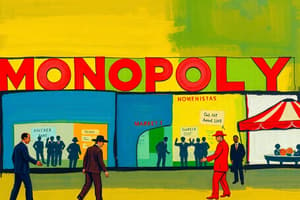Podcast
Questions and Answers
What results from the transition from perfect competition to monopoly?
What results from the transition from perfect competition to monopoly?
- An increase in producer surplus only
- No change in consumer surplus
- A decrease in consumer surplus (correct)
- An increase in consumer surplus
What characterizes a natural monopoly?
What characterizes a natural monopoly?
- Firms in the same industry experience increasing average costs
- Multiple firms can produce at a lower cost
- One firm can supply the entire market at a lower average cost (correct)
- Natural monopolies always require government regulation
If a natural monopoly is unregulated, which price and quantity does it produce?
If a natural monopoly is unregulated, which price and quantity does it produce?
- Pm and Qm (correct)
- Pl and Ql
- Pr and Qr
- Pc and Qc
Why is it challenging to regulate a natural monopoly at the competitive price level?
Why is it challenging to regulate a natural monopoly at the competitive price level?
What is the best alternative for price setting in a regulated natural monopoly to ensure the firm's survival?
What is the best alternative for price setting in a regulated natural monopoly to ensure the firm's survival?
At what quantity does the monopolist maximize profit?
At what quantity does the monopolist maximize profit?
What is the price set by the monopolist at the profit-maximizing quantity?
What is the price set by the monopolist at the profit-maximizing quantity?
What is the marginal cost (MC) at the profit-maximizing output level of 10?
What is the marginal cost (MC) at the profit-maximizing output level of 10?
Which equation correctly represents marginal revenue (MR) in the given context?
Which equation correctly represents marginal revenue (MR) in the given context?
How much profit does the monopolist make at the profit-maximizing quantity?
How much profit does the monopolist make at the profit-maximizing quantity?
What price should a typical supermarket manager set relative to marginal cost?
What price should a typical supermarket manager set relative to marginal cost?
What is the average cost (AC) at the profit-maximizing output?
What is the average cost (AC) at the profit-maximizing output?
What defines an economic agent's market power?
What defines an economic agent's market power?
What is a defining characteristic of a monopoly?
What is a defining characteristic of a monopoly?
Which of the following is NOT a source of monopoly power?
Which of the following is NOT a source of monopoly power?
How can economies of scope contribute to a monopoly?
How can economies of scope contribute to a monopoly?
What role do patents play in maintaining a monopoly?
What role do patents play in maintaining a monopoly?
In what scenario does a firm have monopoly power?
In what scenario does a firm have monopoly power?
Why may defining an industry as a monopoly be complex?
Why may defining an industry as a monopoly be complex?
Which industry example illustrates a monopoly despite competition in other forms?
Which industry example illustrates a monopoly despite competition in other forms?
What is typically required for a firm to be classified as a price maker in a monopoly?
What is typically required for a firm to be classified as a price maker in a monopoly?
What does marginal cost for a supermarket include?
What does marginal cost for a supermarket include?
What is the mark-up percentage typically used by most supermarkets?
What is the mark-up percentage typically used by most supermarkets?
In a multi-plant monopolist, which condition must be satisfied to maximize profit?
In a multi-plant monopolist, which condition must be satisfied to maximize profit?
What is the relationship between MR and MC in a monopolistic market outcome?
What is the relationship between MR and MC in a monopolistic market outcome?
How does monopoly typically impact prices and quantities compared to competitive markets?
How does monopoly typically impact prices and quantities compared to competitive markets?
What is deadweight loss in the context of monopoly power?
What is deadweight loss in the context of monopoly power?
In the numerical example provided, how is the marginal cost function defined for Plant 1?
In the numerical example provided, how is the marginal cost function defined for Plant 1?
Which of these elements does not contribute to the concept of consumer and producer surplus in monopoly analysis?
Which of these elements does not contribute to the concept of consumer and producer surplus in monopoly analysis?
Why is marginal revenue (MR) less than price (P) in a monopoly?
Why is marginal revenue (MR) less than price (P) in a monopoly?
What does it mean that a monopolist does not have a supply curve?
What does it mean that a monopolist does not have a supply curve?
How can a monopolist sell the same quantity at different prices?
How can a monopolist sell the same quantity at different prices?
What is the condition for a monopolist to maximize profit?
What is the condition for a monopolist to maximize profit?
In monopoly pricing, where should a monopolist avoid pricing?
In monopoly pricing, where should a monopolist avoid pricing?
What happens when the demand curve shifts for a monopolist?
What happens when the demand curve shifts for a monopolist?
Why does a monopolist have a different output decision compared to perfect competition?
Why does a monopolist have a different output decision compared to perfect competition?
What does it imply if a monopolist is operating on the inelastic portion of the demand curve?
What does it imply if a monopolist is operating on the inelastic portion of the demand curve?
Flashcards are hidden until you start studying
Study Notes
Monopoly Overview
- Defined by one seller servicing multiple buyers with a unique product lacking substitutes.
- Entry barriers protect the monopoly from competitors.
- Monopolists act as price makers while often maintaining a single price.
Classification and Power of Monopoly
- Existence of monopoly is industry-dependent; examples may show monopolistic traits without absolute control.
- Boundary definitions are subjective; monopoly power hinges on available substitutes.
- Historical examples include the post office, which faced competition from alternate communication methods.
Sources of Monopoly Power
- Key Inputs Control: Ownership of exclusive supply resources allows monopolies to restrict access for competitors (e.g., De Beers in diamonds).
- Economies of Scope: Multi-product firms reduce average costs across various products, hindering single-product competitor entry.
- Legal Protections: Patents, copyrights, and licenses create barriers for competition, maintaining firm dominance.
Characteristics of Monopolist Pricing
- Marginal Revenue (MR) is typically less than price (P) due to downward-sloping demand curves; this reflects the pricing power of monopolists.
- Monopolists do not have a traditional supply curve, as they set both price and quantity based on market demand.
Maximizing Profit
- Monopolists maximize profit where Marginal Cost (MC) equals Marginal Revenue (MR).
- Output and pricing decisions are intricate; changing demand can yield different pricing for the same quantity sold.
- Example profit calculations highlight how prices, average costs (AC), and output shift in a monopolistic context.
Market Power Implications
- Market power enables a firm to influence prices above marginal costs, affecting overall market dynamics.
- In scenarios with several supermarkets, firms adjust pricing strategies based on customer elasticity; supermarkets generally mark prices about 10-11% above MC.
Multi-Plant Firms
- Monopolists often operate multiple plants with distinct cost structures; profit maximization occurs when MC equals MR across all facilities.
- Graphical analysis supports the output distribution across plants ensuring optimal operation.
Welfare and Social Costs of Monopoly
- Monopolies typically lead to higher prices and reduced output, impacting producer and consumer surplus negatively.
- Deadweight loss emerges when monopolist pricing diverges from competitive market scenarios, highlighting resource allocation inefficiencies.
Natural Monopolies
- Characterized by a single firm capable of supplying the whole market at lower costs than multiple firms due to significant economies of scale.
- Regulatory challenges arise as natural monopolies producing at unregulated prices can lead to failures if forced to charge competitive rates.
Regulation Techniques
- Regulating prices for natural monopolies involves balancing firm viability and market fairness; regulators aim to align price with average cost to prevent financial loss while ensuring maximum output without eliminating competition.
Studying That Suits You
Use AI to generate personalized quizzes and flashcards to suit your learning preferences.




